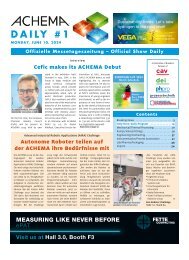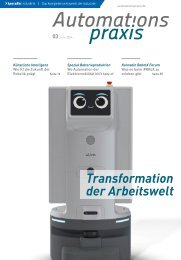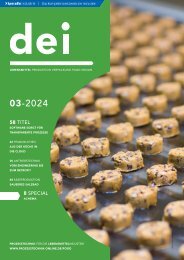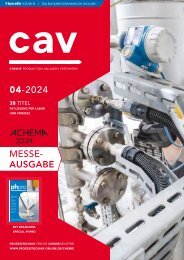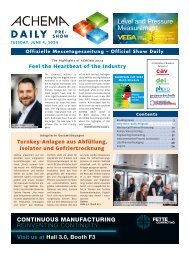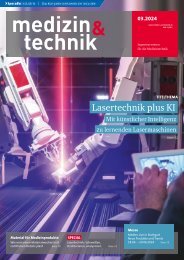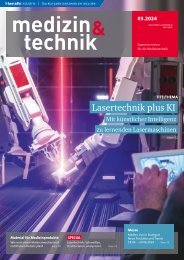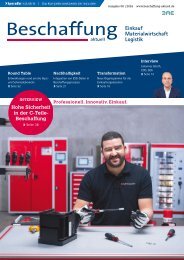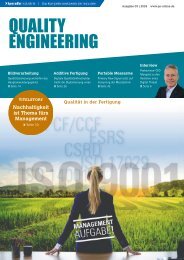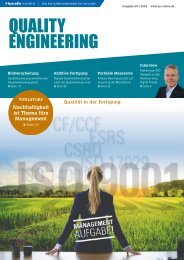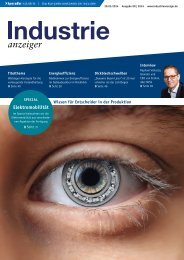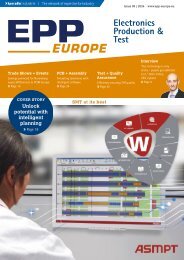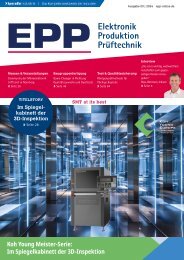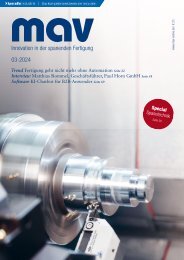cpp – Process technology for the chemical industry 01.2019
The journal cpp - Process technology for the chemical industry reports about processes, plants, apparatus and components for the chemical and pharmaceutical industry. Further topics are IT technologies, industry 4.0, digital production, MSR and automation technology and process analysis technology. The content spectrum is rounded off by explosion protection, plant safety, occupational health and safety, maintenance, site management and energy management.
The journal cpp - Process technology for the chemical industry reports about processes, plants, apparatus and components for the chemical and pharmaceutical industry. Further topics are IT technologies, industry 4.0, digital production, MSR and automation technology and process analysis technology. The content spectrum is rounded off by explosion protection, plant safety, occupational health and safety, maintenance, site management and energy management.
Create successful ePaper yourself
Turn your PDF publications into a flip-book with our unique Google optimized e-Paper software.
®<br />
Innovations <strong>for</strong> heating<br />
Flexible<br />
electical<br />
heating <strong>technology</strong><br />
• Chemical heated hoses<br />
• Transfer- / delivery hoses<br />
• Ex-heated hoses<br />
• Barrel heaters<br />
All instruments needed <strong>for</strong> <strong>the</strong> autonomous inerting unit are installed in a stainless steel<br />
cabinet close to <strong>the</strong> process component<br />
• Pipe trace heaters<br />
• Heating plates<br />
cal applications demand <strong>the</strong> highest levels<br />
of quality and safety, <strong>for</strong> example <strong>the</strong> manufacture<br />
of active pharmaceutical ingredients,<br />
agro<strong>chemical</strong>s or dietary supplements. As a<br />
standardised system, it minimises <strong>the</strong> ef<strong>for</strong>t<br />
<strong>for</strong> validation because <strong>the</strong> complete documentation<br />
is already approved. In addition,<br />
<strong>the</strong> modular design enables individual<br />
inerting systems tailored to actual needs,<br />
which can be upgraded at any time without<br />
difficulty.<br />
Safe inerting in three phases<br />
The SIL level is determined by analysing <strong>the</strong><br />
failure behaviour of <strong>the</strong> components concerned<br />
and checking <strong>the</strong>m <strong>for</strong> redundancies,<br />
continuity and errors. The Heinkel<br />
inerting concept is based on <strong>the</strong> principle of<br />
flow-through inerting. As soon as <strong>the</strong> process<br />
component is switched on, <strong>the</strong> nitrogen<br />
inerting system is activated. During<br />
<strong>the</strong> first, diagnostic phase, <strong>the</strong> leak-tightness<br />
of <strong>the</strong> process housing as well as of <strong>the</strong> connecting<br />
pipework between <strong>the</strong> inerting<br />
cabinet and <strong>the</strong> process component is tested<br />
by charging with a predefined inert gas<br />
flow, where a set increase in pressure has to<br />
be achieved. This test is time-controlled and<br />
safely monitored by means of a pressure<br />
transmitter. If it is successful, <strong>the</strong> second,<br />
rinsing phase introduces a large amount of<br />
nitrogen into <strong>the</strong> process housing. During<br />
this initial inerting, <strong>the</strong> oxygen content is<br />
reduced below <strong>the</strong> process-specific requirement.<br />
The rinsing phase is likewise timecontrolled<br />
and monitored by a flowmeter.<br />
In <strong>the</strong> final phase, a continuous supply of<br />
inert gas compensates plant-specific or operational<br />
leakage flows and pressure variations.<br />
Single or redundant monitoring of<br />
<strong>the</strong> pressure housing is possible depending<br />
on <strong>the</strong> SIL level. All instruments needed <strong>for</strong><br />
<strong>the</strong> autonomous inerting unit are installed<br />
in a stainless steel cabinet close to <strong>the</strong> process<br />
component.<br />
www.<strong>cpp</strong>-net.com<br />
Online search: <strong>cpp</strong>0119heinkel<br />
Hall 4A, Booth 128<br />
AUTHOR:<br />
TOBIAS HÄNLE<br />
Manager Automation,<br />
Heinkel <strong>Process</strong> Technology<br />
AUTHOR:<br />
HELGE FIEDLER<br />
Product Manager,<br />
Heinkel <strong>Process</strong> Technology<br />
• Special solutions<br />
We exhibit!<br />
Nuremberg<br />
9.- 11.04 2019<br />
hall 4, booth 4-197<br />
Hillesheim GmbH<br />
Am Haltepunkt 12<br />
D-68753 Waghäusel • Germany<br />
Phone.: +49 72 54 / 92 56-0<br />
E-Mail: info@hillesheim-gmbh.de<br />
www.hillesheim-gmbh.com<br />
<strong>cpp</strong> 01-2019 31



